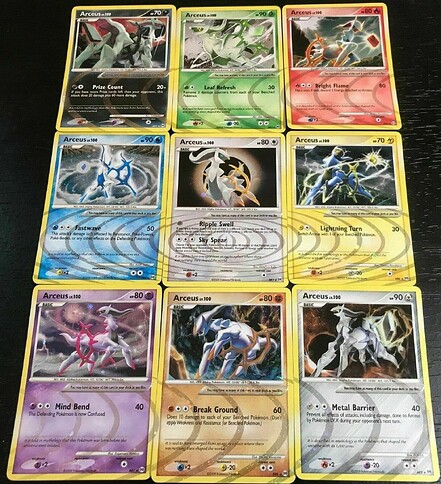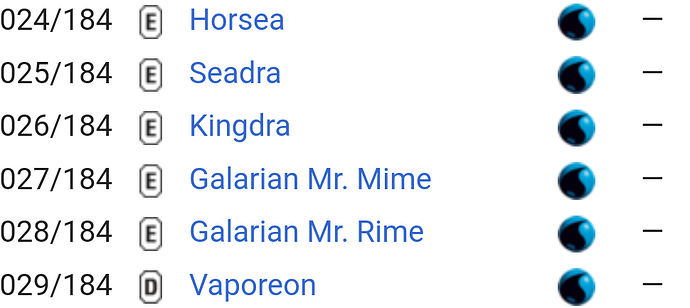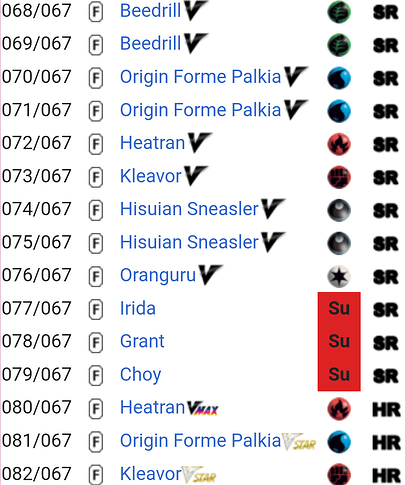Click Here to see Set Rarities version of this article
Modern Set Order Structure
Note: Pokemon 151 is an exception to this structure and instead puts Pokemon into their Kanto Pokedex order.
A. Main Set
- Card Number ≤ Set Number
- Includes Common

 , Uncommon
, Uncommon 
 , Rare
, Rare 
 , Double Rare
, Double Rare 
 and ACE Spec
and ACE Spec 

- Each rarity does have a particular placement in the set structure
Note: Certain “Specialty Sets” sometimes do not have rarities within the main set for Commons, Uncommons, and Rares in TPC
versions
1. Pokemon
→ ordered by National Pokedex* within each type
*Note: Evolution lines from multiple generations are grouped together by whichever Pokemon is lowest in Pokedex number. Example: Pichu would come before Pikachu in a set despite having a higher National Dex number
| Order | Type | |
|---|---|---|
| 1 | Grass | |
| 2 | Fire | |
| 3 | Water | |
| 4 | Lightning | |
| 5 | Psychic | |
| 6 | Fighting | |
| 7 | Darkness | |
| 8 | Metal | |
| 9 | Dragon | |
| 10 | Colorless |
2. Trainers
→ Grouped by type and alphabetical (TPC ![]() )
)
→ Alphabetical only (TPCI ![]() )
)
| Order | Trainer type | |
|---|---|---|
| 1 | Item | |
| 2 | Tool | |
| 3 | Supporter | |
| 4 | Stadium |
3. Special Energy
→ placed at the end of the main set
B. Secret Rares
Note: ordering within each group follows the same rules as above
- Card Number > Set Number (or otherwise specified)
0. Shinies (if applicable)
→ Baby Shinies ![]()
![]() followed by Shiny Full Arts
followed by Shiny Full Arts ![]()
![]()
1. Special Arts without texture
→ Pokemon ![]()
![]()
2. Full Arts
→ Pokemon followed by Supporters ![]()
![]()
3. Special Arts with texture
→ Pokemon followed by Supporters ![]()
![]()
4. Gold Cards
- Pokemon, Trainers (follows main set ordering), then Energy


Set Structure Changes Over Time
Original Era (Baseline)
Japan
Japan’s sets did not have any set numbers until VS Series in 2001. While they were grouped by types (the order of which would change over time), there were no set numbers to represent this externally. Instead, the Pokemon’s Pokedex number would be in the slot where there would normally be a set number. Trainers did not have a number at all.
International
→ ordered alphabetically within each group
- Main Set
-
- Holo Rares
Pokemon
Trainers
Energy
- Holo Rares
-
- Pokemon
Rare
Uncommon
Common
- Pokemon
-
- Trainers
Rare
Uncommon
Common
- Trainers
-
- Energies
Special
Basic
- Energies
- Secret Rares
Pokemon
Trainers
Energies
Note: Legendary Collection had Special Energies before trainers in the main set
e-Series/New Back era
VS Series
VS Series was the very first e-Series set, released exclusively in Japan. For the first time in Japan, cards would now be listed by a set number instead of their Pokedex number.
Numbering by Type 
Now that Japan had the set number system, it would begin the current system of ordering the main set by type → pokedex number (although international sets continued to number by Alphabetical order within Rarities at this time). The exact order of the Colorless type would change depending on the set/era, until BW.
- Pokemon
 Grass
Grass
 Fire
Fire
 Water
Water
 Lightning
Lightning
 Psychic
Psychic
 Fighting
Fighting
 Colorless
Colorless (Sometimes placed after Metal)
 Darkness
Darkness
 Metal
Metal - Trainers
Items
Supporters
Technical Machines(if present)
Stadiums - Special Energies
- Secret Rares
Note: Japan’s version of Expedition (Base Expansion Pack) had a unique ordering, likely due to it was constructed/presented
ADV/EX era
Ultra Rares (Pokemon ex, LV. X, Prime, EX, etc..)
Generation 3 introduced Pokemon ex, which were a higher rarity than Holo Rares and placed after Special Energies in International Sets (but before Secret Rares and Basic Energy Cards.) Japan sets would include these in the main set alongside Common, Uncommon, and Rare Pokemon.
International Set Ordering
Applicable from EX Ruby & Sapphire → Call of Legends
Main Set (as before with Holo Rares first, followed by Rare Pokemon, etc)
- “Ultra Rares”
(ex, LV.X, Prime) - Next Higher Rarity
(Gold Star, LEGEND) - Basic Energy
Secret Rares (Box Topper, JP Super Rare)
BW era
Numbering by Type 
- Applicable from Black and White Base → Current day
All languages would now adopt the ordering by type / Pokedex method introduced in the e-Series era by Japan.
the type order would also be revised and become what is still used today:
- Pokemon
 Grass
Grass
 Fire
Fire
 Water
Water
 Lightning
Lightning
 Psychic
Psychic
 Fighting
Fighting
 Darkness
Darkness
 Metal
Metal
 Dragon
Dragon (New)
 Colorless
Colorless - Trainers
(Alphabetical within each type of trainer
/ Alphabetical among all trainers )
)
 Items
Items
 Supporters
Supporters
 Stadiums
Stadiums - Special Energies
- Full Arts
(Secret Rares for
/ end of main set for )
) - Gold Cards
Full Arts
These come after the main set. Japan called these Super Rares (SR) and they would have Secret Rare numbering, but for International sets, their card numbers would still be within the main set.
Gold Cards
The first few sets that had this new type of secret rare did not have gold foiling. Japan would call these Ultra Rares (UR) while International sets would note these as Secret Rares
XY era
Fairy Type
Introduced in the XY games, Fairy Type ![]() was also introduced into the TCG, but would discontinue by SwSh. For set order, Fairy type comes after Metal and before Dragon
was also introduced into the TCG, but would discontinue by SwSh. For set order, Fairy type comes after Metal and before Dragon
SM era
New Rarity between Full Arts and Gold Cards
Originally, these would be “Rainbow Cards” (HR - Hyper Rare for TPC / Rainbow Rares for TPCI), but in SV, this rarity would be completely replaced by Textured Special Arts
(S) Shiny / (SSR) Shiny Super Rare (TPC)
Introduced in Ultra Shiny GX / Hidden Fates, Pokemon created two new rarities alongside these new types of Shinies. When featured in a set, (and not part of a subset), these are the first Secret Rares, placed before regular Full Arts. There has been one of these types of sets for each generation since (up through SV so far).
(CHR) Character Rare (TPC)
Non-textured special art reprint with artwork prominently featuring a Trainer accompanying the Pokemon. The international implementation of these placed them as Secret Rares, before Rainbow Rares. When they would return in SwSh, the TPC placement would be the same (Secret Rare), except they would come before Full Arts. The Special Art counterparts to these (Art Rares) would occupy the same placement in a set order
SWSH era
Introducing Special Art Rarities
SwSh era helped solidify the presents of “Special Arts”, but with it brought a disagreement on what to call them. Thankfully, TPC introduced much needed new rarities for “Special Arts”
(CSR) Character Super Rare (TPC) - Textured Character Art
An addition to the SM incarnation of Character Rares, notably, these are textured. They are placed after Full Arts, but before Hyper Rares and Gold Cards if printed outside of a holiday sets. If in a holiday set (Like VMAX Climax where they were introduced, they would be before the SR Full Arts)
(AR) Art Rare (TPC) - Special Art without texture
(SAR) Special Art Rare (TPC) - Special Art with texture
AR and SARs were Introduced in the final set of SwSh, this concept continued into the SV era. SARs would eventually replace the HR rarity and be placed after Full Arts, but before Gold Cards
Note on naming
Because there was no official rarity yet, the “AA” or “SA” would be added as a suffix at the end of the existing rarity unofficially.
- a special art “V” or GX would be a “SR SA” (Super Rare Special Art) and a VMAX would be a “HR SA” (Hyper Rare Special Art)
- While sometimes Special Arts would be placed in a similar spot of the set list as a Hyper Rare (After SRs, Before URs), in the SwSh era, it would come after the non-special art version of the card.
for example:
in Eevee Heroes
- Umbreon V Super Rare (084/069) → Umbreon V Super Rare Special Art (085/069)
- Umbreon VMAX Hyper Rare (094/069) → Umbreon VMAX Hyper Rare Special Art (095/069)
in Evolving Skies
- Umbreon V Ultra Rare Full Art (188/203) → Umbreon V Ultra Rare Full Art Special Art (189/203)
- Umbreon VMAX Rainbow Rare (214/203) → Umbreon VMAX Rainbow Rare Special Art (215/203)
SV era
Scarlet and Violet era is the next major overhaul to the Set Structure, but specifically, for TPCI sets.
End of Full Arts in the Main Set (TPCI)
Now, TPCI would also have all Full Arts as Secret Rares, coming after the main set. Prior, they would still be after the trainers, but have card numbers less than the set number.
Tool/Item Split
Going forward, “Tool” Cards would no longer be affected by cards that interact with “Item” Cards
 Item
Item Tool
Tool
End of Rainbow Cards
Rainbow Cards are now replaced with textured Special Arts (SAR/SIR) in rarity and set placement
Subsets
Specifically referring to a set within a set. Typically having a unique set number, yet still found in the same booster packs.
EX Unseen Forces - Unown
all of the Unowns were grouped in their own subset with the numbering being ![]() /28 - example: Unown Q would be
/28 - example: Unown Q would be Q/28
DPt era - Shinies (SH)
- Stormfront
- Platinum
- Platinum: Supreme Victors
- Platinum: Arceus
Each set has 3 cards adding to the total subset from SH1 and ending with SH12 in Platinum: Arceus. In Japanese sets, these had a special glossy surface and star foil pattern and were placed after the non-shiny version of the Pokemon in the sets.
Rising Rivals - Rotom (RT)
In the Japanese counterpart, these Rotoms had a special glossy surface and star foil treatment similar to the Shinies of the same era. In the international set, they were in their own subsection, ordered alphabetically, followed by the accompanying trainer (Charon’s Choice) as the last card (RT6)
Platinum Arceus - Arceus (AR)
These were released in various theme decks in Japan, they feature Arceus in each of the TCG types (at the time), ordered by the foil pattern on the cards
Call of Legends - Shinies (SL)
Subset that featured Shiny Pokemon that were released as various Promos in JP. They had a foil border similar to the previous LV.X from DP/Pt and ex from ADV-PCG/EX.
Legendary Treasures - Radiant Collection (RC)
From the TPC “Shiny Collection” (SC) mini set. These focused on being “cute” mostly, and had a special sort of foiling.
Generations - Radiant Collection (RC)
Same concept as the Legendary Treasures iteration, except these were from the PokeKyun miniset (CP3).
Hidden Fates - Shiny Vault (SV)
Featuring the S (Baby Shiny) and SSR (Full Art Shiny) cards from GX Ultra Shiny as well as some other miscellaneous chase cards that didn’t fit the “main” set like Full Art Supporters, Rainbow Rares, and Gold Cards.
Shining Fates - Shiny Vault (SV)
Same concept as the SM version, this time pulling from the TPC - Shiny Star V.
Celebrations
These cards do not have unique set numbers, but share a similar sort of foil/texture treatment. They are reprints from previous eras. In Asian languages, they were distributed in various methods ranging from promos for products to part of a separate pack given for purchasing the main set.
SWSH era - Trainer Gallery (TG)
- Brilliant Stars
- Astral Radiance
- Lost Origin
- Silver Tempest
A subset spread out across SwSh year 3 TPCI sets which featured the CHR (non-textured Character Arts), CSR (Textured Character Arts), Full Art Supporters, and Gold cards from TPC’s VMAX Climax as well as the additional CHR and CSR cards released in TPC’s Enhanced Expansion Sets (s9a, s10a, and s11a). While the TG cards would span across all of these sets, each set would have its own subset of cards totaling 30 per set (TG01/TG30 - TG30/30).
Crown Zenith - Galarian Gallery (GG)
Similar to the Trainer Gallery, this was a subset created as an answer to a TPC set (VSTAR Universe) which had the newly introduced AR and SAR Special Art rarities.
Definitions/Disclaimers
TPC
in this article refers to The Pokemon Company who as of now prints cards in Japanese, Traditional Chinese, Simplified Chinese, Thai, and Indonesian cards.
- TPC did not always print cards for these languages. There may be some discrepancies for non-JP Asian language cards.
- I have not bothered to investigate between all of the various eras and iterations of the Pokemon Company’s Corporate Hierarchy. Example, Oldback cards may be simply referred to as Japan.
- also, AFAIK, Korea still prints their own cards and their set ordering system may vary from the examples I listed above.
TPCI
refers to The Pokemon Company International which prints the cards for all other languages not covered by TPC
- similar to with TPCI, older eras may simply be referred to as “international” instead of TPCI since I’m pretty sure the breakdown we have now was not the case in the early few eras (nor is it relevant to the overall goal of this article
Thanks for reading. If you have any suggestions or corrections that I should make, please feel free to share in this thread
as of year two of Scarlet and Violet ↩︎





